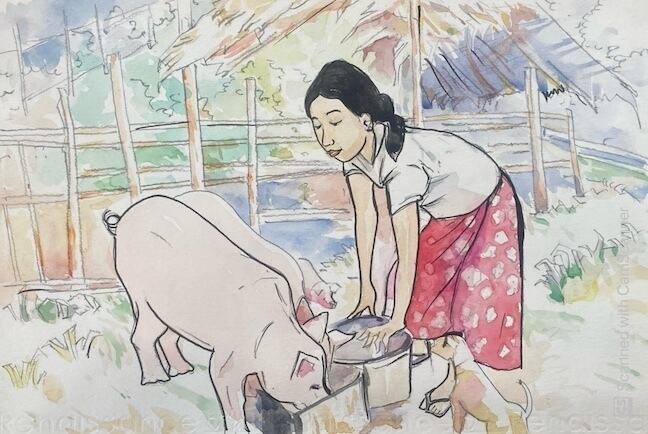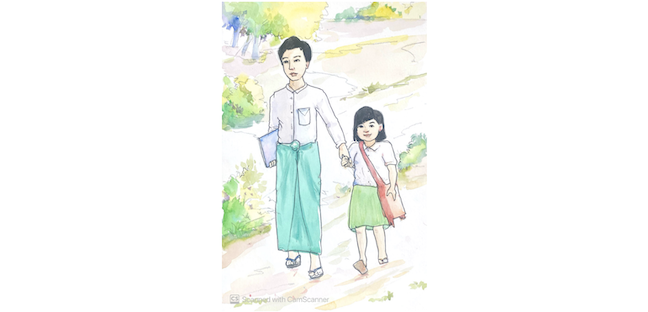1.4 A day in the life of a teacher
Teachers can have many different backgrounds. In the context of mass displacement, it is common to find teachers who have moved into teaching from different careers, or who have never taught before, as well as teachers who have a lot of experience and have taught in many different environments.
Below are some real life examples of teachers who teach in areas where there are many migrant learners, or in one of the refugee camps, along the Thai Myanmar border.
Phyu Phyu: a teacher of migrants in Mae Sot

Phyu Phyu, a 42-year-old teacher and mother, resides in a small Burmese community in Mae Sot, Thailand. She starts her day at 6 a.m., preparing meals for her family before cycling to the school where she teaches migrant children. Her 25-minute bike journey is fraught with concerns about avoiding the police, due to her undocumented status in Thailand. She also has to avoid stray dogs, especially during the rainy season.
Arriving at school, Phyu Phyu’s first tasks involve tidying up and welcoming students and then assessing their well-being and needs, such as whether they have lunch. Some students, new to Thailand and from low-income families, often come without meals.
The school accommodatees about 30 students per class and is overcrowded and noisy, lacking real walls between classrooms. Adding to Phyu Phyu’s worries, the school’s lease on the rented land will expire next year, which could affect her job security.
Phyu Phyu juggles multiple responsibilities, from supervising the school bus to maintaining cleanliness and sometimes covering other classes if colleagues leave. With only two breaks and a full schedule that includes watching over students during lunch and attending frequent training sessions and meetings, her days are long and exhausting.
With 20 years’ experience of teaching, Phyu Phyu is motivated by the needs of migrant children she observes in Mae Sot. Despite the challenges, the joy and resilience of her students inspire her to continue making a difference through education.
Tharamu Toe Ki Poe: a teacher in a Karen refugee camp

Tharamu Toe Ki Poe, a dedicated teacher and mother of three, resides in a Karen refugee camp along the Thai Myanmar border. After completing high school within the camp 15 years ago, she chose to teach in the same community. While awaiting the opportunity to relocate abroad for a better life, she remains dedicated to educating local children.
The school where Tharamu teaches is constructed from bamboo, and there are space and noise issues. The small classrooms are overcrowded, and the absence of dividing walls allows noise to carry from one class to another. It is challenging for teachers to teach in these classrooms and for learners to concentrate. The limited availability of resources further complicates her job. Students have to share textbooks, and the lack of essential teaching materials makes it difficult to implement the training she receives annually.
Beyond her professional challenges, Tharamu faces financial difficulties on her modest salary of 1000 Thai Baht (approximately 27 USD) per month. Although she receives some dried food monthly, it is hardly sufficient to meet the living costs for her family.
After a full day at school, she returns home to tend to household duties such as cooking, cleaning, and laundry, which leaves her exhausted by day’s end. Despite these hardships, Tharamu remains dedicated to her role as an educator, driven by a strong commitment to her students and their future.
Maw Moe Bue: a teacher in a Karenni refugee camp

Maw Moe Bue is a 20-year-old teacher at the Karenni Refugee Camp in Ban Mai Nai Soi. She became a teacher out of necessity, as she had no other job options. She is single but in a relationship with someone who has resettled in the US. Her teaching commitment is for one year, during which she must teach subjects assigned by her school principal, without the freedom to choose. Despite her desire to pursue further education, she is bound by her current commitment.
To supplement her limited teacher’s salary, Maw Moe Bue raises pigs. Her house is about 10-15 minutes from the school. She often returns home stressed and immediately begins house chores, including cooking for pigs, preparing family meals, and fetching water. She also supports her younger sibling’s education. Despite the challenges, she remains dedicated to her role and responsibilities, both at school and at home.
Aung Aung: a teacher in a migrant learning centre in Ranong

Aung Aung is 22 years old and has been working as a teacher for almost two years. He lives in Ranong with his sister near a noisy market. Although he would like to live in a quieter place, he cannot afford it because he sends money to his parents in Myanmar.
Aung Aung teaches science and social studies, but he doesn’t feel confident as a teacher because he lacks experience and he feels he hasn’t received enough teacher training. He also finds teaching difficult due to a lack of teaching resources, and so he has asked his colleagues to help him get materials like a globe or measuring cups for science classes. Every morning, he thinks about how to teach and he works hard to prepare his lessons. He listens to suggestions from other teachers and managers to improve his work. With support and guidance from his team, he has become more confident over time.
He feels shy speaking in front of students and struggles to manage those who misbehave, arrive late, skip homework, or fight. Despite these challenges, he wants to help the children get an education. He believes learning is essential, and he loves his students, who love him in return. Helping his migrant community makes him feel proud.
Aung Aung feels accomplished when he solves problems at school and when his students succeed.
What do the teachers’ stories tell us about the life of a teacher?
The stories share several similar problems that teachers must solve:
- Children are often hungry, affecting concentration;
- Classrooms are overcrowded;
- Classrooms are noisy, affecting students’ concentration;
- Teachers have multiple responsibilities, such as hygiene and covering for absent staff;
- Teachers are exhausted at the end of the day;
- There are limited resources available;
- Teachers need help in designing lesson plans and materials;
- Teachers receive little support in learning how to manage their classrooms.
The above scenarios illustrate how working in contexts of mass displacement or other challenging environments can be tough for teachers everywhere. It can be easy to think that as teachers we are stuck in environments that are not conducive to learning. But despite the challenges, we can still imagine how we would like our teaching and learning environment to be. And if we can imagine it, maybe we can find ways of bringing it into being.
Exercise: add a post to the “Day in the Life Padlet”
Add a post on the Day in the Life Padlet about a day in your life as a teacher.
You might like to answer the following questions:
- What kinds of challenges do you face in your context?
- What have you done to address them?
- What aspects of your job do you enjoy the most?
Over to you
Sometimes life as a teacher can feel isolating. Looking at the stories in this step or on the Padlet, can you find any similarities with your own experiences? Have you found ways of dealing with them that others might find helpful? Share your experience in the forum.
